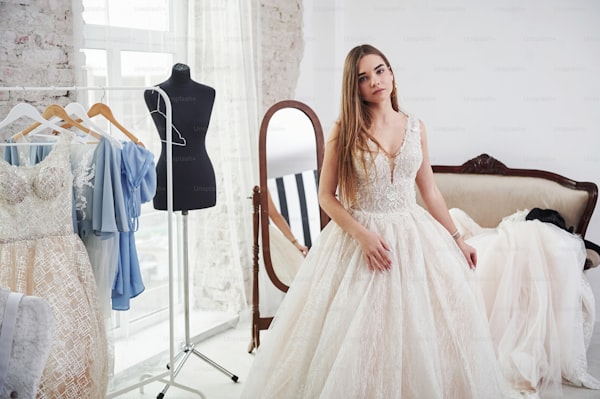Mastering Production Costs in Wedding Dress Design: The Art of Using Rare and Expensive Fabrics
Mastering Production Costs in Wedding Dress Design: The Art of Using Rare and Expensive Fabrics
How Do You Manage Production Costs When Using Rare or Expensive Fabrics for Wedding dresses?
In the ever-evolving world of fashion, particularly within the wedding dress industry, the dream of crafting a stunning gown from luxurious fabrics can sometimes be overshadowed by financial concerns. The question arises: how do you manage production costs when using rare or expensive fabrics for Wedding dresses? This article explores strategies for balancing quality and cost, ensuring that your bridal collection not only dazzles but is also financially viable.
Understanding the Cost of Rare and Expensive Fabrics
The allure of rare and expensive fabrics, such as silk chiffon, lace, and embroidered organza, is undeniable. These materials can elevate a wedding dress from ordinary to extraordinary. However, understanding the cost implications is essential. Factors influencing fabric costs include:
- Sourcing: Rare fabrics may have limited availability and longer lead times.
- Quality: High-quality materials often come with a higher price tag, but they also provide better draping and a luxurious feel.
- Processing: Specialized care and techniques may be required in handling these materials.
Price Comparison of Common Wedding Dress Fabrics
| Fabric Type | Average Cost per Yard | Common Uses |
| Silk | $20 - $50 | Flowy gowns, elegant overlays |
| Lace | $30 - $100 | Details, full gowns |
| Organza | $10 - $30 | Structural elements, layering |
| Satin | $15 - $50 | Classic styles, sleek silhouettes |
| Chiffon | $10 - $40 | Lightweight gowns, overlays |
As illustrated in the table above, the costs associated with each fabric type can vary significantly. Understanding these costs allows designers to make informed decisions about which fabrics to use without exceeding their budget.
Strategies to Manage Production Costs
Designing Wedding dresses with rare and expensive fabrics doesn't necessarily mean breaking the bank. Here are several strategies that can help you manage production costs effectively:
1. Choose the Right Supplier
Establishing relationships with reputable suppliers can lead to better pricing and more options for fabric sourcing. Always compare different suppliers and inquire about bulk purchasing discounts. Negotiating terms can also help secure more favorable pricing.
2. Plan Your Collection Wisely
Designing a cohesive collection allows you to utilize leftover fabric efficiently. For instance, if you purchase silk for one dress, consider how you can creatively use any leftovers in other pieces. This not only minimizes waste but also maximizes the value of your investment.
3. Hybrid Designs
Combine less expensive fabrics with accents of rare materials. For example, a satin gown can be adorned with lace appliqués, creating a luxurious look without the full cost of a lace gown. This technique allows for the visual impact of high-end fabrics while maintaining budget control.
4. Streamline Production Processes
Efficiency in production can significantly reduce costs. Implementing techniques such as just-in-time manufacturing ensures that materials are ordered only when needed, thus reducing fabric holding costs. Additionally, maintaining a strong communication line with your production team can help streamline the workflow.
5. Consider Customization and Pre-Orders
Offering customization options or accepting pre-orders can help gauge interest in designs before committing to fabric purchases. This method not only minimizes risks but also helps ensure that only the necessary amounts of expensive fabrics are acquired.

Examples of Effective Cost Management
Many designers have successfully managed production costs by creatively using rare fabrics. For instance, renowned designer Vera Wang often incorporates luxurious laces, silks, and organzas but carefully balances these elements with more affordable fabrics. This strategy allows her to deliver beautifully crafted gowns at varying price points for brides on different budgets.
Additionally, Monique Lhuillier showcases stunning lace work and intricate beading while maintaining cost-effective designs. By using less expensive materials in conjunction with more luxurious accents, she has built a brand that resonates with brides worldwide.
Future Trends in Wedding Dress Fabrics
As we look forward, the demand for unique and personalized Wedding dresses continues to rise. Emerging trends highlight:
- Eco-friendly materials: Sustainability is becoming increasingly important, prompting designers to explore organic fabric sources.
- Technological advancements: Innovations in fabric production could lead to more affordable options that do not sacrifice quality.
Utilizing Digital Tools
Leveraging digital design tools can also create efficiencies in both design and production processes. Programs that allow you to visualize and adjust designs can lead to more precise fabric requirements, ultimately saving both time and costs.
Final Thoughts
Managing production costs when using rare or expensive fabrics for Wedding dresses can seem daunting, but with the right strategies in place, it is entirely feasible. By understanding fabric costs, choosing quality suppliers, planning wisely, and leveraging production efficiencies, designers can create stunning collections that reflect both luxury and value.
Whether you are a burgeoning designer or an established name in the wedding dress industry, always keep the balance between luxury and affordability in mind. Engage with your clientele to understand their needs and incorporate their desires to achieve a successful and profitable collection. Remember, the journey of crafting a beautiful wedding dress is as important as the final product, and financial vigilance is key to sustaining that journey.
